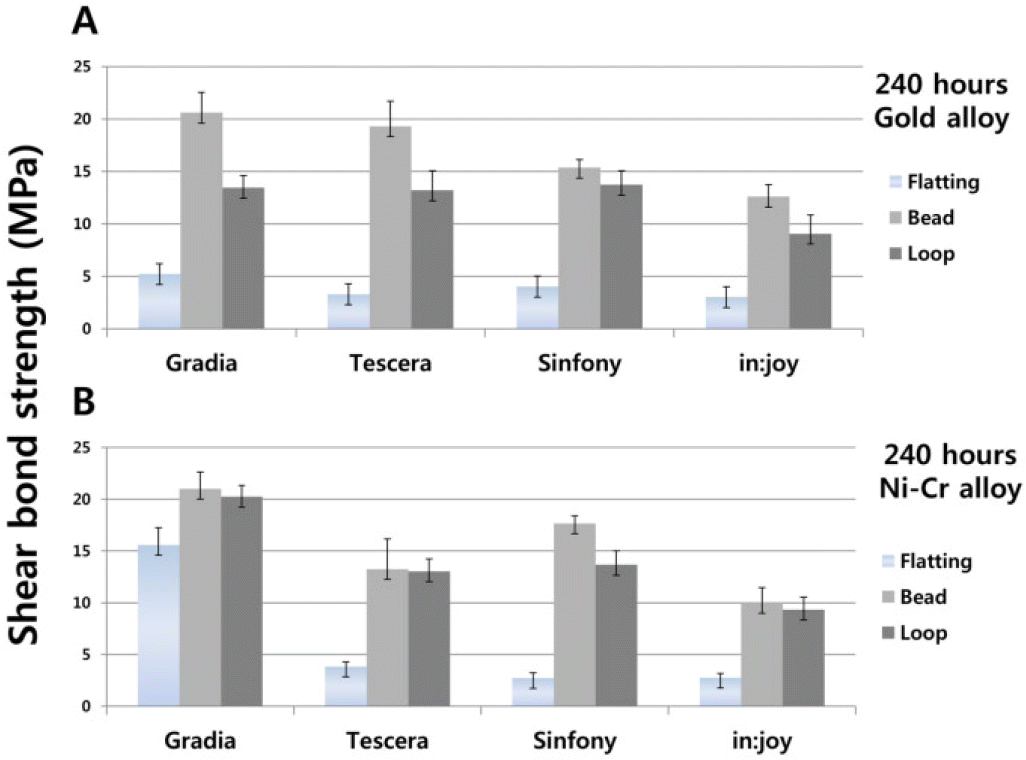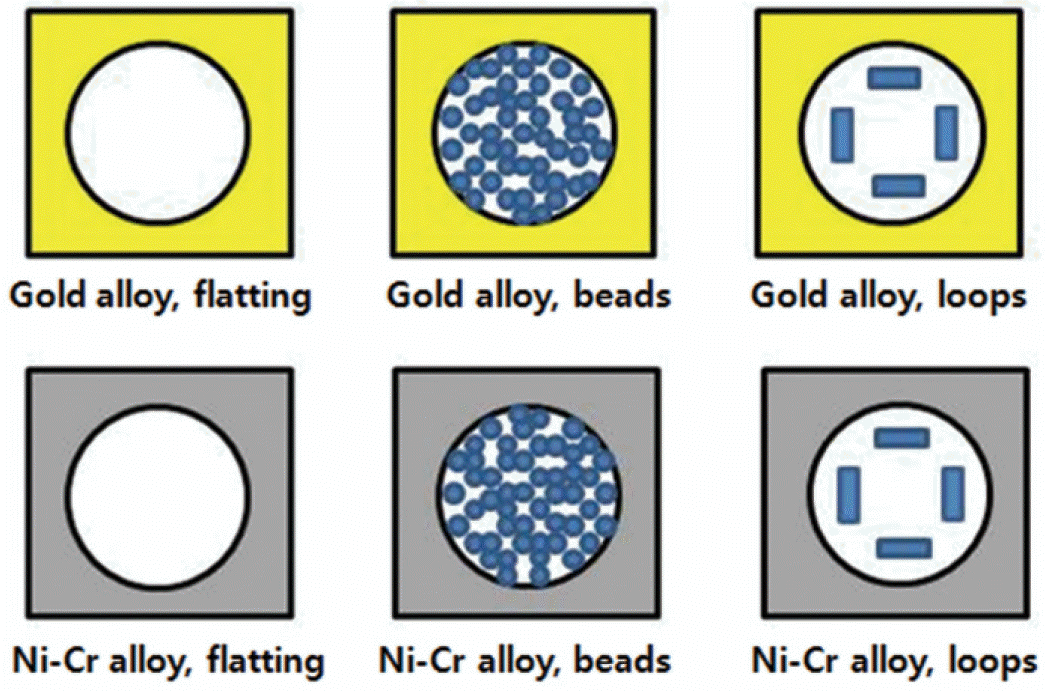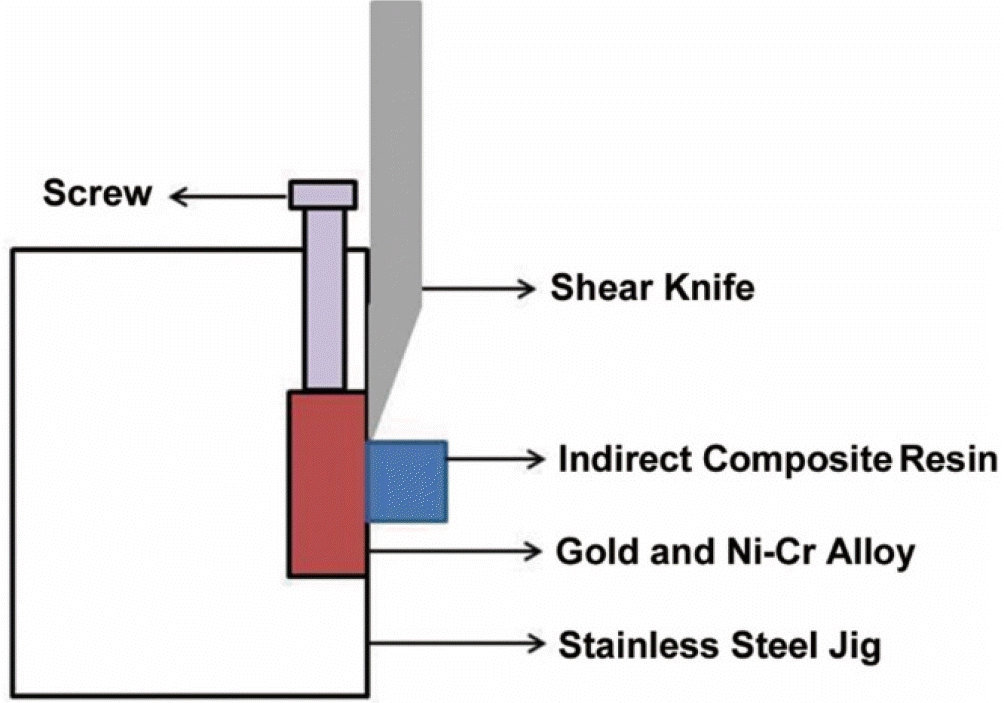Abstract
Purpose
The purpose of this study is to investigate the differences in bond strength of four different indirect composites to the gold alloy and Ni-Cr alloy according to type of metal surface treatment after water storage.
Materials and methods
Type IV gold alloy and Ni-Cr alloy were used for casting alloy while four types of indirect composite resins (Gradia, Tescera Sinfony and in;joy) were used in this study. Metal specimens were produced by casting and total of 240 specimens (60 specimens per one indirect composite group) were prepared. After bonding indirect composite resin and undergoing 24 hours of polymerization, customized jig was attached to the metal specimen and shear bond strength were measured using universal testing machine. Also, differences in shear bond strength before and after water storage for 240 hours were also measured.
Results
In the measurement of shear bond strength according to the metal surface treatments, bead group showed high strength followed by loop and flatting group (P<.05). After being stored in water bath for 240 hours, Gradia showed statistically significant high bond strength compared to other indirect composite resins in all groups (P<.05).
Conclusion
Shearbond strength was found to be different according to type of metal surface treatment and type of metal used after storage in water. Further studies need to be developed for clinical practices as three are still problems of microleakage, stain or wear. (J Korean Acad Prosthodont 2017;55:264-71)
Go to : 
REFERENCES
1.Joshi N., Patil NP., Patil SB. The abrasive effect of a porcelain and a nickel-chromium alloy on the wear of human enamel and the influence of a carbonated beverage on the rate of wear. J Prosthodont. 2010. 19:212–7.

2.Barzilay I., Myers ML., Cooper LB., Graser GN. Mechanical and chemical retention of laboratory cured composite to metal surfaces. J Prosthet Dent. 1988. 59:131–7.

3.Touati B., Aidan N. Second generation laboratory composite resins for indirect restorations. J Esthet Dent. 1997. 9:108–18.

4.al-Hiyasat AS., Saunders WP., Sharkey SW., Smith GM., Gilmour WH. Investigation of human enamel wear against four dental ceramics and gold. J Dent. 1998. 26:487–95.

5.Lee CF., Pierpont HP., Strickler ER. The effect of bead attachment systems on casting patterns and resultant tensile bond strength of composite resin veneer cast restorations. J Prosthet Dent. 1991. 66:623–30.

6.Setz J., Engel E. In vivo color stability of resin-veneered telescopic dentures: a double blind pilot study. J Prosthet Dent. 1997. 77:486–91.

7.Matsumura H., Kawahara M., Tanaka T., Atsuta M. Surface preparations for metal frameworks of composite resin veneered prostheses made with an adhesive opaque resin. J Prosthet Dent. 1991. 66:10–5.

8.Zidan O. Etched base-metal alloys: comparison of relief patterns, bond strengths and fracture modes. Dent Mater. 1985. 1:209–13.

9.Meiers JC., Jensen ME., Mayclin T. Effect of surface treatments on the bond strength of etched-metal resin-bonded retainers. J Prosthet Dent. 1985. 53:185–90.

10.Creugers NH., Welle PR., Vrijhoef MM. Four bonding systems for resin-retained cast metal prostheses. Dent Mater. 1988. 4:85–8.

11.Ishijima T., Caputo AA., Mito R. Adhesion of resin to casting alloys. J Prosthet Dent. 1992. 67:445–9.

12.Tanaka T., Atsuta M., Uchiyama Y., Nakabayashi N., Masuhara E. Spherical powder for retaining thermosetting acrylic resin veneers. J Prosthet Dent. 1978. 39:295–303.

13.Nicholls JI., Shue SL. Effect of bead spacing on the tensile bond strength of resin veneers to cast alloys. Quintessence Dent Technol. 1986. 10:511–5.
14.Shue SL., Nicholls JI., Townsend JD. The effect of metal retentive designs on resin veneer retention. J Prosthet Dent. 1987. 58:297–305.

15.Sarafianou A., Seimenis I., Papadopoulos T. Effectiveness of different adhesive primers on the bond strength between an indirect composite resin and a base metal alloy. J Prosthet Dent. 2008. 99:377–87.

16.Völlm L. Rocatec-new bonding system for synthetic resin technic. Dent Labor (Munch). 1989. 37:527–30. 533–5.
17.Tiller HJ., Magnus B., Goebel R., Garshke A. Sand-blasting process and its use in surface conditioning of dental alloys. Quintessenz. 1985. 6:1927–34. 2151-8.
18.Yoshida K., Taira Y., Sawase T., Atsuta M. Effects of adhesive primers on bond strength of self-curing resin to cobalt-chromium alloy. J Prosthet Dent. 1997. 77:617–20.

19.Naegeli DG., Duke ES., Schwartz R., Norling BK. Adhesive bonding of composites to a casting alloy. J Prosthet Dent. 1988. 60:279–83.

20.Tanaka T., Hirano M., Kawahara M., Matsumura H., Atsuta M. A new ion-coating surface treatment of alloys for dental adhesive resins. J Dent Res. 1988. 67:1376–80.

21.Matsumura H., Yanagida H., Tanoue N., Atsuta M., Shimoe S. Shear bond strength of resin composite veneering material to gold alloy with varying metal surface preparations. J Prosthet Dent. 2001. 86:315–9.

22.Yamashita M., Koizumi H., Ishii T., Nakayama D., Oba Y., Matsumura H. Adhesive performance of silver-palladium-copper-gold alloy and component metals bonded with organic sulfur-based priming agents and a tri-n-butylborane initiated luting material. Acta Odontol Scand. 2013. 71:196–204.

23.Ikemura K., Kojima K., Endo T., Kadoma Y. Effect of novel dithiooctanoate monomers, in comparison with various sulfur-containing adhesive monomers, on adhesion to precious metals and alloys. Dent Mater J. 2011. 30:72–8.

24.Kern M., Thompson VP. Influence of prolonged thermal cycling and water storage on the tensile bond strength of composite to NiCr alloy. Dent Mater. 1994. 10:19–25.

25.Moulin P., Picard B., Degrange M. Water resistance of resin-bonded joints with time related to alloy surface treatment. J Dent. 1999. 27:79–87.

26.Knobloch LA., Kerby RE., Seghi R., van Putten M. Two-body wear resistance and degree of conversion of laboratory-processed composite materials. Int J Prosthodont. 1999. 12:432–8.
27.Ciftçi Y., Canay S., Hersek N. Shear bond strength evaluation of different veneering systems on Ni-Cr alloys. J Prosthodont. 2007. 16:31–6.
28.Almilhatti HJ., Giampaolo ET., Vergani CE., Machado AL., Pavarina AC. Shear bond strength of aesthetic materials bonded to Ni-Cr alloy. J Dent. 2003. 31:205–11.

29.Petridis H., Garefis P., Hirayama H., Kafantaris NM., Koidis PT. Bonding indirect resin composites to metal: Part 1. Comparison of shear bond strengths between different metal-resin bonding systems and a metal-ceramic system. Int J Prosthodont. 2003. 16:635–9.
Go to : 
 | Fig. 3.Mean shear bond strength between metal surface treatments after 24 hours. (A) Mean shear bond strength of gold alloy specimens, (B) Mean shear bond strength of Ni-Cr alloy specimens. |
 | Fig. 4.Mean shear bond strength between metal surface treatments after 240 hours. (A) Mean shear bond strength of gold alloy specimens, (B) Mean shear bond strength of Ni-Cr alloy specimens. |
 | Fig. 5.Gold alloy specimen surfaces after shear bond strength measurement (In order of flatting, bead and loop). |
 | Fig. 6.Ni-Cr alloy specimen surfaces after shear bond strength measurement (In order of flatting, bead and loop). |
Table 1.
The composite veneering resins used in this study
Table 2.
Shear bond strength (MPa) groups for incubation and metal and surface; Bonferroni tests of four indirect composite resins




 PDF
PDF ePub
ePub Citation
Citation Print
Print




 XML Download
XML Download